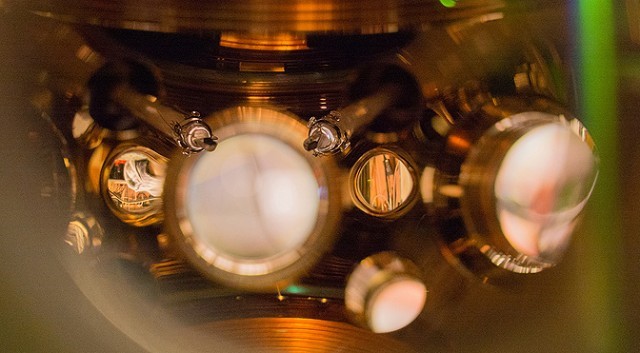
Considering that 90% of American adults own mobile phones, the practice of interrupting strangers to inquire about the time has almost completely disappeared. Since these devices are so prolific in our lives, we place a great deal of faith in them and assume the time they tell us, which is synchronized and passed down from the mobile carrier, is always correct. This high level synchronization is ultimately derived from atomic clocks, the most accurate form of time-keeping on the planet. Now, scientists are developing an atomic clock so accurate, that it’ll take over 15 billion years before the clock loses or gains a single second; that’s longer than our universe has even been in existence!
Located at the JILA, the joint research and learning institute operated by the National Institute of Standards and Technology (NIST) and the University of Colorado Boulder, the clock is three times more accurate than it was but a year ago when it set the record for accuracy, as well as improving its stability between ticks by 50 percent. The clock’s accuracy is measured by tracking closely the clock approaches the resonant frequency where the strontium atoms oscillate between two differing energy levels.
Meaning, the JILA clock is able to measure tiny changes in the passage of time and the forces of gravity at different heights, overcoming the issue of clocks ticking faster at higher elevations as was predicted by Einstein’s theory of relativity.
“Our performance means that we can measure the gravitational shift when you raise the clock just 2 centimeters on the Earth's surface,” JILA/NIST explains Fellow Jun Ye in the press release. “I think we are getting really close to being useful for relativistic geodesy.” This is a major improvement over a few years ago, when the clock could only measure the shift when moving the clock 12 inches.
The JILA/NIST clock holds thousands of strontium atoms in an “optical lattice,” a 30-by-30-micrometer column of about 400 regions formed by a powerful red laser. By channeling the laser at the exact frequency needed to make the atoms switch their energy levels, scientists can then detect the 430 trillion ticks per second. In addition, two platinum resistance thermometers were installed in the clock’s vacuum chamber to help measure and maintain the atom’s thermal environment and a radiation shield was used to surround the atom chamber, permitting the clock to operate at room temperature — a huge differentiating factor from the near-cryogenic temperatures most atomic clocks require.
“The clock operates at normal room temperature,” Ye said. “This is actually one of the strongest points of our approach, in that we can operate the clock in a simple and normal configuration while keeping the blackbody radiation shift uncertainty at a minimum.”
The race to improve atomic time-keeping serves far more than to earn scientific boasting rights, it enhances our global positioning and communication systems with optimized data synchronization (a factor of paramount importance in information systems), and improves 3D measurements of the shape of the Earth.
Source Extremetech via NIST
Advertisement
Learn more about Electronic Products Magazine





